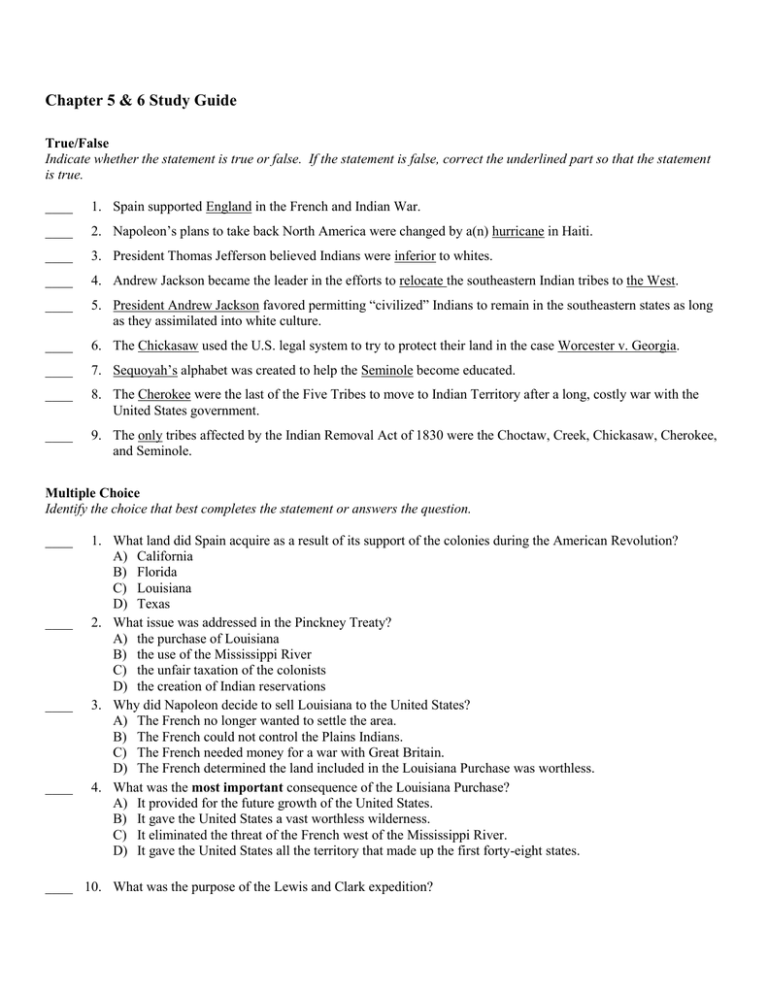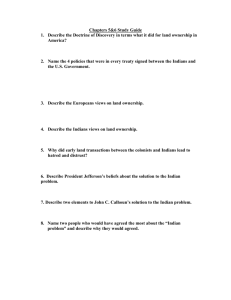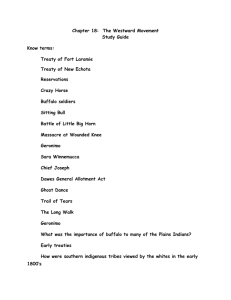Chapter 5 & 6 Study Guide
advertisement

Chapter 5 & 6 Study Guide True/False Indicate whether the statement is true or false. If the statement is false, correct the underlined part so that the statement is true. ____ 1. Spain supported England in the French and Indian War. ____ 2. Napoleon’s plans to take back North America were changed by a(n) hurricane in Haiti. ____ 3. President Thomas Jefferson believed Indians were inferior to whites. ____ 4. Andrew Jackson became the leader in the efforts to relocate the southeastern Indian tribes to the West. ____ 5. President Andrew Jackson favored permitting “civilized” Indians to remain in the southeastern states as long as they assimilated into white culture. ____ 6. The Chickasaw used the U.S. legal system to try to protect their land in the case Worcester v. Georgia. ____ 7. Sequoyah’s alphabet was created to help the Seminole become educated. ____ 8. The Cherokee were the last of the Five Tribes to move to Indian Territory after a long, costly war with the United States government. ____ 9. The only tribes affected by the Indian Removal Act of 1830 were the Choctaw, Creek, Chickasaw, Cherokee, and Seminole. Multiple Choice Identify the choice that best completes the statement or answers the question. ____ ____ ____ ____ 1. What land did Spain acquire as a result of its support of the colonies during the American Revolution? A) California B) Florida C) Louisiana D) Texas 2. What issue was addressed in the Pinckney Treaty? A) the purchase of Louisiana B) the use of the Mississippi River C) the unfair taxation of the colonists D) the creation of Indian reservations 3. Why did Napoleon decide to sell Louisiana to the United States? A) The French no longer wanted to settle the area. B) The French could not control the Plains Indians. C) The French needed money for a war with Great Britain. D) The French determined the land included in the Louisiana Purchase was worthless. 4. What was the most important consequence of the Louisiana Purchase? A) It provided for the future growth of the United States. B) It gave the United States a vast worthless wilderness. C) It eliminated the threat of the French west of the Mississippi River. D) It gave the United States all the territory that made up the first forty-eight states. ____ 10. What was the purpose of the Lewis and Clark expedition? A) to explore California B) to explore the Mississippi River C) to explore the Louisiana Purchase D) to explore the land between the Appalachian Mountains and the Mississippi River ____ 11. What economic activity took place in the Three Forks area? A) lumbering B) manufacturing C) mining D) trading ____ 17. What was unusual about the Battle of New Orleans? A) It was fought after the war ended. B) It was the decisive battle of the war. C) It exposed the weakness of the U.S. navy. D) It resulted in the British loss of the Mississippi River. ____ 18. What issue was addressed in the Missouri Compromise? A) American Indians B) roads and railroads C) slavery D) taxation ____ 19. Indian tribes that had moved into Oklahoma by the early 1800s included all of the following except the A) Comanche. B) Delaware. C) Kichai. D) Seminole. ____ 20. What was the first federal fort to be built in present-day Oklahoma? A) Fort Coffee B) Fort Gibson C) Fort Towson D) Fort Washita ____ 21. What was the purpose for building Fort Towson? A) to protect nearby towns from Indian attacks B) to provide protection for men building railroads C) to regulate trade between the Indians and whites D) to establish a border between Oklahoma and Kansas ____ 22. What Indians gave up a large portion of their land in the Treaty of Doak’s Stand? A) Choctaw B) Creek C) Seminole D) Seneca ____ 23. The five major tribes of Indians located in the southeastern United States included all of the following except the A) Cherokee. B) Chickasaw. C) Comanche. D) Creek. ____ 26. What discovery led to the final Indian removal from Georgia? ____ 27. ____ 28. ____ 29. ____ 30. A) gold B) oil C) silver D) zinc What was Sequoyah’s major contribution to the Cherokee culture? A) the development of a syllabary B) the invention of a printing press C) the preservation of native music D) the establishment of a yearly festival Which southeastern Indian tribe was the first to be encouraged by the U.S. government to relocate to the Indian Territory? A) Cherokee B) Chickasaw C) Choctaw D) Creek Who was a Choctaw chief during the period of their removal to Indian Territory? A) John Coffee B) Greenwood Leflore C) Menawa D) John Ross The commission headed by Montfort Stokes improved conditions for the Indians in Indian Territory in all of the following way except A) settling and defining land boundaries. B) seeing that troops were kept at Fort Gibson. C) bringing together eastern and western tribes. D) permitting some Indians to return to their old homes. Completion Complete each statement. 1. A conflict between France and Great Britain over land in the Ohio River Valley led to the ___________________________________ War. 2. Resentment in the American colonies to British taxation was one of the causes of the ______________________________ War. 3. Thomas Jefferson sent ___________________________________, the U.S. Minister to France, to try to purchase New Orleans. 4. ___________________________________ was president of the United States when the Louisiana Purchase was made. 5. The United States bought the Louisiana Purchase for $ _________________________. 6. Stephen Long’s expedition mistook the ____________________ River for the Arkansas River. 7. Rivers were important to early commerce. Three major rivers, the ____________________, the ____________________, and the ____________________, joined near present-day Muskogee in an area called the Three Forks. 8. During the War of 1812, Francis Scott Key wrote the _____________________________________________. 9. As result of the Missouri Compromise, ____________________ was added to the Union as a free state. 10. Indian Territory was bordered by the states of ____________________ and Arkansas on the east. 11. The capital of the Cherokee was located at _________________________, Georgia. 12. The Choctaw ceded all its lands east of the Mississippi River and agreed to move to Indian Territory in the Treaty of _____________________________________________. 13. The Chickasaw agreed to sell their land east of the Mississippi River in the Treaty of ______________________________. 14. The Cherokee agreed to sell their eastern lands by the terms of the Treaty of _________________________. Matching Match each letter to the correct tribe. 1. 2. 3. 4. 5. Cherokee Chickasaw Creek Seminole Choctaw a. b. c. d. e. f. g. h. i. j. k. l. m. n. o. p. q. r. s. Refused removal by armed resistance Used the U.S. legal system to fight removal 1st to sign removal treaty Last to remove Treaty of New Echota Treaty of Pontotoc Creek Treaty of Indian Springs Killed members of tribe for signing removal treaties Greenwood Leflore Treaty of Dancing Rabbit Creek Had the easiest removal of all of the 5 Civilized Tribes Osceola William/ Chilly McIntosh Treaty Party Treaty of Payne’s Landing Treaty of Washington Moshulatubbee Quote attributed to this tribe that removal had been a “trail of tears and death” War to remove tribe cost $20 million and the lives of 1,500 troops 1. Chilly McIntosh 2. Samuel Worcester 3. Osceola 4. John Ridge 5. John Ross 6. William McIntosh 7. Elias Boudinot 8. Andrew Jackson 9. Major Ridge 10. Thomas Jefferson a. b. c. d. e. f. g. h. Supported removal Members of the Treaty Party Opposed removal President that favored assimilation President when Indian Removal Act was passed Killed for signing removal treaty Translated the Bible into Cherokee Member of one of the Five Civilized Tribes The only other part of the test will be questions from the Cherokee removal video. That part of the test will be open note!!







